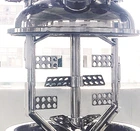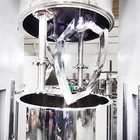Integrating development, manufacturing and sales, as a first-level mixer emulsifier factory.
The Importance of Heating and Cooling Systems in Industrial Mixers
Industrial mixing processes often involve complex materials that require careful handling to maintain their quality and performance. One key factor that can significantly impact the efficiency and outcome of mixing is temperature control—specifically, the use of heating and cooling systems integrated into industrial mixers.
Whether you are mixing adhesives, food products, chemicals, or pharmaceuticals, maintaining the right temperature during the mixing process is essential to ensure product consistency, prevent degradation, and speed up production. In this article, we’ll explore why heating and cooling systems matter, how they work, and what features to consider when selecting your next industrial mixer.
Why Temperature Control Matters in Industrial Mixing
- Material Sensitivity: Many materials are sensitive to temperature changes—too much heat can cause curing, degradation, or phase separation, while too little may result in incomplete mixing or viscosity problems.
- Consistency and Quality: Precise temperature control ensures a uniform mix, preventing lumps, air entrapment, or uneven texture.
- Process Efficiency: Proper heating or cooling can reduce mixing time, increase throughput, and lower energy costs by optimizing the process conditions.
- Safety: Some materials release fumes or become hazardous if overheated, making temperature regulation critical for workplace safety.
How Heating and Cooling Systems Work in Industrial Mixers
Most industrial mixers use jackets or internal coils around the mixing vessel to control temperature:
- Heating Jackets: Circulate hot water, steam, or oil to raise the temperature of the material gently and evenly. This is crucial for materials that need softening or controlled curing.
- Cooling Jackets: Use chilled water or refrigerants to remove heat generated by mixing or to keep temperature-sensitive materials stable.
- Dual Systems: Some mixers have both heating and cooling capabilities, allowing precise temperature cycling within a single batch or continuous process.
These systems are often integrated with sensors and automated controls for real-time monitoring and adjustment.
Key Benefits of Heating and Cooling in Mixing
- Improved Product Quality: Prevents overheating and product damage, ensuring consistent texture and performance.
- Versatility: Enables mixing of temperature-sensitive materials such as silicones, adhesives, pharmaceuticals, and food products.
- Reduced Downtime: Minimizes batch failures and rework, increasing overall productivity.
- Energy Savings: Optimizes energy use by only applying heat or cooling when needed.
- Scalability: Supports both small batch and large-scale continuous mixing applications.
What to Look for When Choosing Mixers with Heating and Cooling Systems
- Temperature Range and Accuracy: Ensure the system can reach and maintain the required temperatures for your specific product.
- Uniform Heat Transfer: Even heating or cooling prevents hot/cold spots that can affect product quality.
- Automation and Controls: Programmable logic controllers (PLCs) or temperature controllers improve precision and ease of operation.
- Material Compatibility: Jackets and vessels should be made from corrosion-resistant materials suited to your product chemistry.
- Safety Features: Pressure relief valves, alarms, and automatic shutdowns protect equipment and operators.
- Cleaning and Maintenance: Easy access for cleaning prevents contamination, especially important in food or pharmaceutical applications.
Examples of Applications Benefiting from Temperature-Controlled Mixing
- Silicone and Rubber Processing: Controlled heating softens the material for easier mixing and curing.
- Adhesives and Sealants: Temperature control prevents premature curing and ensures proper polymerization.
- Pharmaceuticals: Sensitive ingredients require strict temperature regulation to maintain efficacy.
- Food and Beverage: Cooling systems maintain freshness and prevent spoilage during mixing.
- Chemical Manufacturing: Precise temperature control ensures safe and efficient chemical reactions during mixing.
Final Thoughts: Temperature Control Is Not an Optional Extra
In industrial mixing, temperature is a critical parameter that directly affects product quality, process efficiency, and safety. Integrating heating and cooling systems into your mixers gives you the control needed to handle a wider range of materials, reduce waste, and optimize production times.
When selecting your next industrial mixer, make sure to evaluate the heating and cooling capabilities alongside mixing power, vessel size, and other features to find the best fit for your product and process needs.













































































































